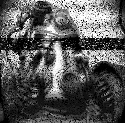|
I forget where I saw a scanned copy of a poster about this but disposal of chemicals in general was incredibly lax in the past. Hell, handyman type magazines actively promoted pouring used motor oil (loaded with carcinogens) on dirt roads to keep the dust down, in gravel filled holes in the backyard for disposal, and on weeds to kill them. "dump it in the river or a pit in the ground" was the disposal method of the day. The only thing we can really do is go after the companies that continued to do it after the point where it became known that it was bad to do this. If Hooker Chemical knew that the poo poo they were dumping and burying was likely to cause real problems and was burying it in ways that weren't guaranteed to contain it forever, sure, nail them for all they're worth, criminal charges, etc. Otherwise... I guess make the dumpers clean the mess up. This is part of what made the asbestos industry incredibly evil - they continued mining and selling horrible stuff for over half a century after it became pretty obvious that their products were causing huge health problems.
|
|
|
|

|
| # ? Jun 9, 2024 10:11 |
|
onemanlan posted:It makes me wonder what compounds that we're currently disposing off willy nilly will be seen as insane in the future due to their health effects. I don't know about explicit chemicals, but I remember a few months ago seeing how exfoliating face scrubs are bad now because they use plastic micro beads that like to play hell with modern water recycling stuff as well as typically finding their way to the ocean to join various garbage patches.
|
|
|
|
RedneckwithGuns posted:I don't know about explicit chemicals, but I remember a few months ago seeing how exfoliating face scrubs are bad now because they use plastic micro beads that like to play hell with modern water recycling stuff as well as typically finding their way to the ocean to join various garbage patches. For that matter, synthetic estrogens from birth control pills (and other sources) wind up in the water after being excreted and do odd things to fish. But then on the other hand the environmental impact of "woman + birth control metabolites" is a great deal less than that of "woman + offspring." So maybe we deal with some odd fish.
|
|
|
|
Phanatic posted:For that matter, synthetic estrogens from birth control pills (and other sources) wind up in the water after being excreted and do odd things to fish. I'm honestly wondering if there's any reliable way to prevent contamination like that. Some theoretical formulation or better water treatment?
|
|
|
RedneckwithGuns posted:I'm honestly wondering if there's any reliable way to prevent contamination like that. Some theoretical formulation or better water treatment? There are treatment methods that remove pharmaceuticals more effectively, like ozonation.
|
|
|
|
|
kastein posted:If Hooker Chemical knew that the poo poo they were dumping and burying was likely to cause real problems and was burying it in ways that weren't guaranteed to contain it forever, sure, nail them for all they're worth, criminal charges, etc. This 1994 decision, in which punitive damages were denied, is a good read. quote:[O]n one occasion I had purchased a new pair of workboots and during that day they became wetted with chemicals from the dump. That evening prior to entering my home I removed the boots and left them sitting in the garage overnight. The next morning in preparation to return to work I found only the soles and heels of the boots remaining. The uppers were entirely eaten away. quote:At the Company's direction, Mr. Wilkenfeld went to the site, where the contractor told him that he was concerned about "some black water that they saw around the foundations that had just been installed for the school building. They were concerned that this might be chemicals and might attack the foundation." Wilkenfeld looked at the black liquid and tested it for acidity or alkalinity by tasting it. It had no taste, and he informed the contractor that, "I didn't think that it was acid or alkaline, and it probably wouldn't attack the foundation. He was satisfied with that, and I left." This Hooker employee was remarkably prescient: quote:In 1944, Mr. Van Horn, who was supervisor of the Hooker Process Study Department, stated in an annual report that:
|
|
|
|
Adenoid Dan posted:There are treatment methods that remove pharmaceuticals more effectively, like ozonation. Yeah, it's largely a matter of how badly you want to clean it up and how much you're willing to spend to do it.
|
|
|
|
onemanlan posted:It makes me wonder what compounds that we're currently disposing off willy nilly will be seen as insane in the future due to their health effects. It's deeper than that. They find just barelydetectable levels of Prozac in the tap water from most homes in the U.K.
|
|
|
|
deratomicdog posted:they tend to call cops blue canaries. Makes sense - Really, they're not actually your friend.
|
|
|
|
RedneckwithGuns posted:I don't know about explicit chemicals, but I remember a few months ago seeing how exfoliating face scrubs are bad now because they use plastic micro beads that like to play hell with modern water recycling stuff as well as typically finding their way to the ocean to join various garbage patches. The worst thing is these bastards *knew* those tiny plastic beads would create an environmental problem, and they still put them in their products. To make it even more reprehensive, crushed walnut shells/olive pits/etc. would work just as well as the plastic beads or better, with no environmental impact, but of course they're a teeny-tiny bit more expensive than those damned plastic beads, so practically no one uses the environmentally sound option. The personal vanity industry has been completely batshit insane and out of control for decades. There's no need to buy special facial scrubs in colored plastic bottles, when coarse salt and olive oil works perfectly well, and has done so for millennia. The modern world is hosed.
|
|
|
|
It is very difficult to sell olive oil and salt in tiny packages to put on your face for $39.99
|
|
|
|
tehloki posted:It is very difficult to sell olive oil and salt in tiny packages to put on your face for $39.99 Slap the words "Dead Sea" on there and you definitely can.
|
|
|
|
Soylent Pudding posted:Slap the words "Dead Sea" on there and you definitely can. artisanal carbon-neutral free range dead sea salt with organic olive oil. Bet you can fetch $79 now.
|
|
|
|
tehloki posted:It is very difficult to sell olive oil and salt in tiny packages to put on your face for $39.99 Call now and we'll send you a 30-day supply for a Risk-Free Trial! After your Risk-Free Trial, we'll send you a new 60-day supply for the low low low price of only $39.99 per month! You can cancel at any time! Your Satisfaction Is Guaranteed! For only $10/month more, we'll upgrade you to the Deluxe Formula which smells like flowers, giving you that Spring Fresh feeling! Call Now, this offer can end at any time!
|
|
|
|
KozmoNaut posted:The worst thing is these bastards *knew* those tiny plastic beads would create an environmental problem, and they still put them in their products. In toothpaste too! http://www.dentalbuzz.com/2014/03/04/crest-imbeds-plastic-in-our-gums/ One of the few things I've looked up on snopes and found verification for.
|
|
|
|
You should all check out the Pseudoscience megathread in the Science and Academics forum. It's full of bullshit products that do nothing. http://forums.somethingawful.com/showthread.php?threadid=3100175
|
|
|
|
We had a local dump that became quite a problem. This is an article from 2009, more recent testing found that groundwater was so badly contaminated that the city dug up roads in the middle of winter to run municipal water to nearby homes.quote:STAMFORD -- In the woods on the northern edge of Scofieldtown Park are remnants of its days as a landfill. Containers lay strewn among the trees -- milk and 7UP bottles that haven't been used since the 1950s.
|
|
|
|
kastein posted:This is part of what made the asbestos industry incredibly evil - they continued mining and selling horrible stuff for over half a century after it became pretty obvious that their products were causing huge health problems. an inhabitant posted:Mothers took their toddlers to go watch the offloading of the ships, who transported the asbestos in huge bags. We loved this as kids. Frank, the tower crane driver, was a friend of mine. Offloading these ships made enormous amounts of dust, because the cranes punctured the bags. All of this dust was blown over to the gardens of the inhabitants. I remember the vegetables in our garden nearly always being covered with a fine white powder. Eternit dismissed all of the studies about asbestos as "vague", "meaningless" or "bad science". They sent scientists to conventions to defend their interests, and to the villages to keep the inhabitants calm. Unions did nothing at all, because they were scared of losing 3000+ jobs. Son of an Eternit labourer posted:Especially my mother was worried. "You're sure it's safe, right Pierre?" In the 80s they couldn't deny the danger any more, so they minimalised it. They told people you needed to inhale massive amounts of asbestos to develop cancer - in truth, just a single fiber is possibly enough. They said they were in compliance with Belgian law, which was true, but only because the lobby kept pushing asbestos laws back. Eventually the Belgian law was only changed in '98. In Western Europe, about 250 000 people will die or have died of mesothelioma between 1995 and 2018. It only starts about 30 years after exposure, so the peak is yet to come. Louis de Cartier de Marchienne, managing director of Eternit, passed away on 21 May 2013 - just a couple of days before the appeal sentence in the trial against Eternit.
|
|
|
|
kastein posted:I forget where I saw a scanned copy of a poster about this but disposal of chemicals in general was incredibly lax in the past. Hell, handyman type magazines actively promoted pouring used motor oil (loaded with carcinogens) on dirt roads to keep the dust down, in gravel filled holes in the backyard for disposal, and on weeds to kill them. "dump it in the river or a pit in the ground" was the disposal method of the day. If you think just plain oil is carcinogenic, oh boy do I have a story. Back in the early 1970s there was a low-income community southwest of St. Louis named Times Beach. Being poor and relatively rural, it had a lot of dirt roads. Maintenance was paying a local handyman to come out and spray oil on the roads at a cost of six cents a gallon. Meanwhile a pharmaceutical company nearby was trying to clean up a disused portion of its facilities; those facilities had been used to manufacture Agent Orange during the Vietnam War. They start paying another company to haul off clay and wastewater from their facilities, and that company in turn began paid people to dispose of it. So the guy in this community offers to take some of the clay and water to start mixing in with the oil he's spraying on the roads. Tests it at his own house, works great! Does an extra good job of keeping the weeds down. He takes it to a horse farm and sprays it there - the farm ends up losing 62 horses. The owners blame the handyman, but he insists he only used straight motor oil. That's a lie, but he assumes it's an innocent one - he doesn't know that the waste he's receiving has 2000 times the levels of dioxin present in Agent Orange. He continues using the spray on the roads and on other farms, but the farmers who lost horses keep an eye on his activities. They find out that horses are getting sick and dying soon after they get weed control treatment. They get the EPA involved, and they discover the true extent of what happened. Turns out the pharmaceutical company was aware of the dioxins, but didn't tell anyone about them. In 1980 the EPA sues them. Soil investigations in 1982 turn up dioxin, in places up to 100 ppb (1ppb is considered hazardous). By 1985, the town is evacuated. By 1987 nearly the entire town and the upper few feet of soil reside in a mound. An incinerator is built in 1996 to destroy the 286,000 tons of debris. Once finished in 1997, the site is handed back over to Missouri and turned into a state park. Of course, Missouri has a habit of doing stuff like that - another state park is a lead mine dating back to the 1700s. Bunch of lead leached from tailings has leached into soil.
|
|
|
|
Just a bit of expansion on the above: for those who are not aware how dangerous dioxin is, ppb stands for Part Per Billion. As in, one part in 1.000.000.000. This means that ONE MILLIGRAM of dioxin equally spread into ONE TON of soil, water, etc, is a hazardous level. In Imperial units, that's one ounce in fifty-six million pounds. poo poo's scary.
|
|
|
|
cgfreak posted:The asbestos industry was loving ridiculous. I live in Belgium which was pretty much the heart of the asbestos lobby. While the link between asbestos and mesothelioma, asbesthosis, lung cancer etc was pretty decidedly proven by the '60s, Belgium was still leading the world in asbestos use per capita well into the 70s. Speaking of asbestos, there's a town in Quebec that is literally called Asbestos: http://en.wikipedia.org/wiki/Asbestos,_Quebec quote:At the 2011 census, 7,096 people resided in Asbestos. It is situated in the centre of a square formed by the cities of Drummondville, Sherbrooke and Victoriaville, and the Nicolet River to the north. It is the site of the Jeffrey mine, until recently the world's largest asbestos mine,[5] which has long been the town's largest employer, and of the now-closed Magnola magnesium refinery. It was the site of the famous 1949 Asbestos Strike. There's another old asbestos mine a little south of there, here in VT. It used to be the main source of asbestos for most of the US in the mid 20th century. http://en.wikipedia.org/wiki/Lowell,_Vermont quote:The Lowell (chrysotile) quarry on Belvidere Mountain was the last asbestos mine to operate in the Eastern U.S. It closed in 1993.
|
|
|
|
See also Wittenoom in Australia. Created as a company town around an asbestos mine, now officially de-towned.
|
|
|
|
The black country is hilarious for this kind of thing: http://www.expressandstar.com/news/local-news/2014/11/13/metro-work-hit-as-old-mine-is-found/ Essentially, they realised while renovating the tramline to wolverhampton around here, they found out that part of the line is built on an old abandonned mineshaft that is partially infilled. potentially that could of collapsed at any time there was a train on it. good times. edit: wait crap this isn't the OHSA thread, woops. Drone_Fragger has a new favorite as of 00:00 on Nov 27, 2014 |
|
|
|
They took Wittenoom off maps because people were driving through just to see the Asbestos that's there (Blue Asbestos / Crocidolite, really, really nasty stuff)and it's hazardous enough to your health just driving through the place. One of my geology lecturers at uni has a piece of Crocidolite that he has set in the centre of an acryllic cube because that's the only way he feels comfortable being around it.
Ignimbrite has a new favorite as of 23:48 on Nov 26, 2014 |
|
|
|
That stuff is actually kind of pretty. Why are the most dangerous things always pretty?
|
|
|
|
Keiya posted:That stuff is actually kind of pretty. Why are the most dangerous things always pretty? The allure of danger I suppose. Back when I was doing mineralogy, I was in a lab learning mineral identification. There was a bag tucked into the corner of a rock tray, so we got curious and opened it. Out plopped a very fine specimen of blue chrysotile, already splintering into fabric. The TA's eyes got huge, scooped it back in the bag and took it to the office. I never saw it again, which is a shame, it would have been an excellent display piece if it had gotten encased in acryllic. Which reminds me, I have a chunk of rock from a serpintine mine from just outside Death Valley I should probably get rid of. We were looking at an ophiolites (chunk of the ocean crust that gets pinched up into mountains when they form, they turn into serpintine when exposed to the elements) and I found a chunk with a calcite crystal the size of my fist. Didn't really think about the asbestos being in the same rock.
|
|
|
|
Mikl posted:Just a bit of expansion on the above: for those who are not aware how dangerous dioxin is, ppb stands for Part Per Billion. I fairly regularly work with dioxin  Funny enough I didn't know it was part of the job until after I was hired and did some research into the subject. Well played immunology lab, well played. Funny enough I didn't know it was part of the job until after I was hired and did some research into the subject. Well played immunology lab, well played.
|
|
|
|
Venusian Weasel posted:The allure of danger I suppose. You should check out Jade Cove in Big Sur some time. Most of the jade has been scooped up by amateur prospectors so you probably won't find any without a boat and wetsuit, but on nice days there are a handful of people combing through the serpentine rock beach looking for jade.
|
|
|
|
Keiya posted:That stuff is actually kind of pretty. Why are the most dangerous things always pretty?
|
|
|
|
Keiya posted:That stuff is actually kind of pretty. Why are the most dangerous things always pretty? Let me tell you about borderline personality disorder.
|
|
|
|
Venusian Weasel posted:If you think just plain oil is carcinogenic, oh boy do I have a story. Back in the early 1970s there was a low-income community southwest of St. Louis named Times Beach. Being poor and relatively rural, it had a lot of dirt roads. Maintenance was paying a local handyman to come out and spray oil on the roads at a cost of six cents a gallon. I've got a book somewhere that's basically 'chemical disasters of the 20th century', the article on the '76 Italian disaster where they did what you described above by accident is stomach turning. Small hint, never look up pictures of Chloracne.
|
|
|
|
Hexyflexy posted:I've got a book somewhere that's basically 'chemical disasters of the 20th century', the article on the '76 Italian disaster where they did what you described above by accident is stomach turning. Small hint, never look up pictures of Chloracne. How about doing it deliberately?
|
|
|
|
We are truly a cancer on the living earth.
|
|
|
|
SciShow did a great YouTube video on 5 of the World's Most Dangerous Chemicals: https://www.youtube.com/watch?v=ckSoDW2-wrc Includes thread favorites such as Azidoazide Azide (C2N14) and is really entertaining to laymen such as myself.
|
|
|
|
I saw that last night, and holy poo poo fluoroantimonic acid is insane.  Ph of -25, and until today I didn't even know that the scale went below 0.
|
|
|
|
Rorac posted:I saw that last night, and holy poo poo fluoroantimonic acid is insane. It has a pKa, a disassociation constant, of -25. pKa is basically how eager the acid is to surrender a proton, is not the same thing as pH.
|
|
|
|
Phanatic posted:It has a pKa, a disassociation constant, of -25. pKa is basically how eager the acid is to surrender a proton, is not the same thing as pH. That's still a little  . Acids below -2 are strong acids. Acetic Acid (vinegar) is about a 4 in water. So -25 is....nuts. Especially when you realize its a logarimthic scale. The strongest acid your local high school chem lab carries is probably hydrobromic, which has pKa of -8. . Acids below -2 are strong acids. Acetic Acid (vinegar) is about a 4 in water. So -25 is....nuts. Especially when you realize its a logarimthic scale. The strongest acid your local high school chem lab carries is probably hydrobromic, which has pKa of -8.How do those strong acids work, anyway? I know below one it completely dissociates, so how do you wind up with a pKa of -25? I never got past acid-base reactions before the calc requirements for my chem degree led to me switching majors, and pchem wasn't my strong suit. Dr Jankenstein has a new favorite as of 10:34 on Dec 15, 2014 |
|
|
|
AA is for Quitters posted:How do those strong acids work, anyway? I know below one it completely dissociates, so how do you wind up with a pKa of -25? I never got past acid-base reactions before the calc requirements for my chem degree led to me switching majors, and pchem wasn't my strong suit. The pKa is effectively about how an acid interacts with other acids (with water really just being an example of an especially weak acid) - if you have a mixed solution of two acids, the relative concentration of each acid and conjugate base will depend on the pKa values. You can use this to work out the relative strength of different acids even if they both dissociate completely in water alone.
|
|
|
|
Phanatic posted:It has a pKa, a disassociation constant, of -25. pKa is basically how eager the acid is to surrender a proton, is not the same thing as pH. What would the pH be then, for that stuff? I came up with -25 with some searching, so I guess the source was incorrect.
|
|
|
|

|
| # ? Jun 9, 2024 10:11 |
|
Rorac posted:What would the pH be then, for that stuff? That's now how pH works. Like, take HCl for example, there's no number you can point to and say that's "the" pH. If you take a particular quantity of HCl and dissolve it in a particular quantity of water, *then* you can calculate/measure "the pH." pH is a metric of how acidic a solution is, you can't talk meaningfully about the pH of just the pure solute. What are you dissolving the H2FSbF6 in, and at what concentration? For comparison, the pKa of hydrogen chloride is about -9.3. So fluoroantimonic acid is way way more willing to surrender a proton than HCl. But that doesn't mean that a gram of fluoroantimonic acid dissolved in a liter of water will be a jillion times more acidic than a gram of HCl dissolved in a liter of water. The latter case, you're going to have around 1.7E22 protons floating around in your solution (well, sort of, in the form of hydronium ions). The former case, you're going to have 3.3E21 protons floating around in your solution (well, sort of, in the form of fluoronium ions). So the pH of a gram of fluoroantimonic acid dissolved in a liter of water will be higher, not as acid, as a the pH of a gram of HCl dissolved in a liter of water. Phanatic has a new favorite as of 22:58 on Dec 15, 2014 |
|
|












































